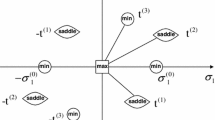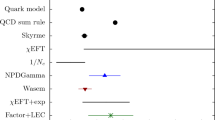Abstract
We investigate the possibility of parity being spontaneously violated in QCD at finite baryon density and temperature. QCD is approximated by a generalized σ model with two isomultiplets of scalars and pseudoscalars. The mechanism of parity violation is based on interplay between lightest and heavier degrees of freedom and it cannot be understood in simple models retaining the pion and nucleon sectors solely. We argue that, in the dense and hot nuclear matter of a few normal densities and moderate temperatures, parity violation may arise due to a second-order phase transition and its occurrence is well compatible with the existence of stable bound state of normal nuclear matter.
Similar content being viewed by others
References
A. B. Migdal, Zh. Eksp. Teor. Fiz. 61, 2210 (1971) [Sov. Phys. JETP. 36, 1052 (1973)]; A. B. Migdal, O. A. Markin, and I. N. Mishustin, Sov. Phys. JETP 39, 212 (1974).
D. Kharzeev, R. D. Pisarski, and M. H. G. Tytgat, Phys. Rev. Lett. 81, 512 (1998); D. E. Kharzeev, L. D. McLerran, and H. J. Warringa, Nucl. Phys. A 803, 227 (2008).
M. Alford, K. Rajagopal, and F. Wilczek, Phys. Lett. B 422, 247 (1998).
C. Vafa and E. Witten, Phys. Rev. Lett. 53, 535 (1984).
A. Andrianov and D. Espriu, Phys. Lett. B 663, 450 (2008).
A. Andrianov, V. Andrianov, and D. Espriu, Phys. Lett. B 678, 416 (2009).
M. Buballa, Nucl. Phys. A 611, 393 (1996).
G. E. Brown and M. Rho, Phys. Rep. 363, 85 (2002).
O. Scavenius, Á. Mócsy, I. N. Mishustin, and D. H. Rischke, Phys. Rev. C 64, 045202 (2001); P. A. M. Guichon and A. W. Thomas, Phys. Rev. Lett. 93, 132502 (2004).
S. Pal, M. Hanauske, I. Zakout, H. Stoecker, and W. Greiner, Phys. Rev. C 60, 015802 (1999).
V. Bernard, Ulf-G. Meissner, and I. Zahed, Phys. Rev. D: Part. Fields 36, 819 (1987).
D. Ebert and K. G. Klimenko, J. Phys. G 32, 599 (2006); Eur. Phys. J. C 46, 771 (2006).
O. Philipsen, Eur. Phys. J. ST152, 29 (2007).
P. Braun-Munzinger, K. Redlich, and J. Stachel, arXiv: nucl-th/0304013.
NICA White Paper, http://theor.jinr.ru/twikicgi/view/NICA/WebHome
M. Gell-Mann and M. Levy, Nuovo Cimento 16, 705 (1960).
B. D. Serot and J. D. Walecka, Int. J. Mod. Phys. E 16, 15 (1997).
Author information
Authors and Affiliations
Corresponding author
Additional information
The article is published in the original.
Rights and permissions
About this article
Cite this article
Andrianov, A.A., Andrianov, V.A. & Espriu, D. (P)arity violation in QCD motivated hadronic models at extreme conditions. Phys. Part. Nuclei 41, 896–900 (2010). https://doi.org/10.1134/S1063779610060146
Published:
Issue Date:
DOI: https://doi.org/10.1134/S1063779610060146




